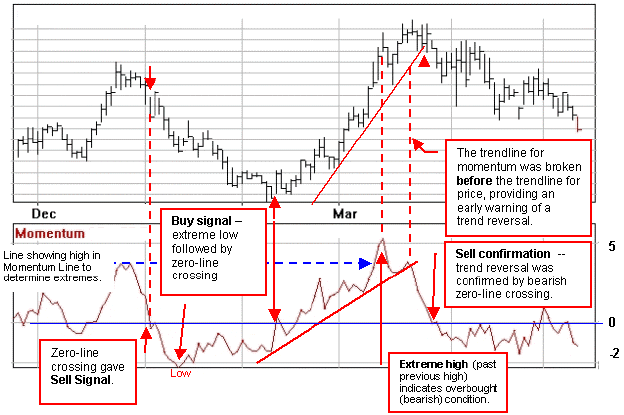MomentumMomentum measures the speed of price change and provides a leading indicator of changes in trend.Overview
InterpretationA strongly trending market acts like a pendulum; the move begins at a fast pace, with strong momentum. It gradually slows down, or loses momentum, stops, and reverses course. The momentum line is always a step ahead of the price movement. It leads the advance or decline in prices and levels off while the current price trend is still in effect. It then begins to move in the opposite direction as prices begin to level off. The 10 day momentum line fluctuates on an open scale around a zero line. When the latest closing price is higher than that of 10 days ago, a positive value is plotted above the zero line. If the latest close is lower than 10 days previous, a negative value is plotted. Ten days or periods are usually used in calculating momentum, but any time period can be employed. The shorter the time frame used the more sensitive momentum becomes to short term fluctuations with more marked oscillations. Oscillator swings are smoother and more stable when a longer number of days are used. Upward Momentum When an uptrending momentum line begins to flatten out it means that the new gains being achieved by the latest closing prices are the same as the gains 10 days earlier. The rate of upward momentum has leveled off even though prices may still be advancing. When the momentum line begins to drop further, below the zero line, the uptrend in prices could still be in force, but the last price gains are less than those of 10 days ago. The uptrend is losing momentum. Downward momentum When the momentum line moves below the zero line, the latest close is now under the close of 10 days ago and a short term downtrend is in effect. As momentum continues to drop farther below the zero line, the downtrend gains momentum. The downtrend decelerates when the line begins to turn around. If loss of momentum is experienced in a market at the same time as selling resistance is met or when buying power is temporarily exhausted, momentum and price peak simultaneously. SignalsMomentum is a basic application of oscillator analysis, designedto measure the rate of price change, not the actual price level. Three common signals are generated by the momentum oscillator: zero-line crossings, trendline violations, and extreme values. Zero-line crossingsAlthough the long-term price trend is still the overriding consideration, a crossing above the zero line could be a buy signal if the price trend is up and a crossing below the zero line, a sell signal, if the price trend is down. Using TrendlinesThe trendlines on the momentum chart are broken sooner than those on the price chart. The value of the momentum indicator is that it turns sooner than the market itself, making it a leading indicator. Extreme ValuesOne of the benefits of oscillator analysis is being able to determine when markets are in extreme areas. At extreme positive values, momentum implies an overbought position; at extreme negative values, an oversold position The absence of a fixed upper and lower boundary presents a difficulty with the momentum line. To help solve this problem look at the long-term history of the momentum line and draw horizontal lines along its upper and lower boundaries. Adjust these lines periodically, especially after important trend changes. |
